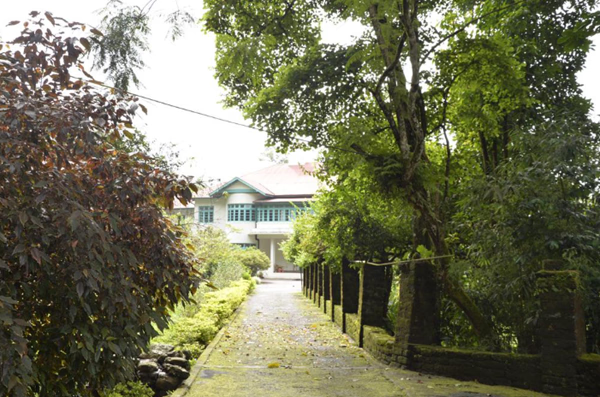 Image Credit: Niebuhr, Uwe (Sept. 14, 2019) via HAV
Image Credit: Niebuhr, Uwe (Sept. 14, 2019) via HAV
Nestled in the picturesque hills of Kalimpong, India, Bhutan House stands as a powerful testament to Bhutan’s rich cultural heritage and its unique diplomatic history.
With its blend of traditional Bhutanese architecture and deep-rooted cultural significance, Bhutan House offers a window into the past, reflecting the resilience and spirit of the Bhutanese people.
Read on to uncover how Bhutan House has played a role in diplomacy and in preserving Bhutan's heritage across generations.
The Origins Of Bhutan House On Kalimpong
Bhutan House in Kalimpong was established in the early 1900s, a significant period for Bhutan's diplomatic relations with British India. The house was built by Raja Kazi Ugyen Dorji, a prominent Bhutanese nobleman, and served as both a residence and a political hub for fostering cultural ties between Bhutan, India, and Tibet.
Located in the serene town of Kalimpong, this estate quickly became a cornerstone of Bhutanese diplomacy, hosting pivotal meetings and key figures from the region.
While Bhutan House in Kalimpong was not a typical Bhutan traditional house, its design incorporated elements of traditional Bhutanese architecture, which favored materials like timber, stone, and beaten earth. These elements reflect Bhutan's architectural heritage, blending the old with the new to create a functional and symbolic residence.
Historically, Bhutanese homes were built to accommodate families, their livestock, and stores. Though the Bhutan House had a different purpose, it retained the cultural essence seen in the layout of a traditional Bhutanese home.
Over time, the house became closely associated with Bhutan's political modernization efforts, playing an instrumental role in shaping the country’s external relations. Today, Bhutan House remains a significant cultural landmark, symbolizing the long-standing diplomatic ties between Bhutan and its neighboring countries.
 Image Credit: Niebuhr, Uwe (Sept. 14, 2019) via HAV
Image Credit: Niebuhr, Uwe (Sept. 14, 2019) via HAV
The Dalai Lama’s Stay At Bhutan House
In 1912, the 13th Dalai Lama sought refuge at Bhutan House in Kalimpong during exile. This house in Bhutan became a symbol of friendship between Bhutan and Tibet.
The Dalai Lama named the house Migyur Ngona Phodrang, meaning "Palace of Unchanging Supreme Joy," and bestowed religious gifts, deepening its cultural importance. His stay elevated Bhutan House into a site of spiritual and historical value, cementing its role in Bhutanese-Tibetan relations.
The Dalai Lama’s presence at Bhutan House elevated its status, transforming it from a political hub into a residence steeped in spiritual history. Today, it remains a living monument to the lasting relationship between Bhutan and Tibet, drawing visitors interested in its architectural and spiritual significance.
Bhutan House Today: A Living Monument
Although it is no longer a typical house in Bhutan or a residence for the public, it continues to hold immense significance. The house is still home to the Queen Grandmother of Bhutan, maintaining its royal connections and prestige.
Unlike traditional Bhutanese houses scattered across rural landscapes, Bhutan House blends traditional Bhutanese elements with its unique history. The structure has been preserved to retain its original charm, offering a glimpse into Bhutan’s past while serving as a living monument to its diplomatic and spiritual legacy.
Though not open to the public, Bhutan House stands as a testament to the country's rich heritage, much like a preserved traditional house in Bhutan. It continues to symbolize the strength of Bhutanese culture and history, attracting admiration from those who know its story.
Conclusion About Bhutan House In Kalimpong
Bhutan House in Kalimpong is a significant monument to Bhutan's history, embodying both cultural and diplomatic milestones. Its deep-rooted connections with Bhutan’s royal family and the Dalai Lama make it an essential part of Bhutan's legacy.
To truly experience Bhutan's unique culture, its traditional homes, and its spiritual landmarks, look no further than Druk Asia, the leading travel agency in Bhutan. With their expert guidance and personalized itineraries, you can immerse yourself in the heart of Bhutan’s history and beauty.
Book your travel with DrukAsia today and discover Bhutan's timeless wonders!
Frequently Asked Questions About Bhutan House In Kalimpong
Can Tourists Visit Bhutan House In Kalimpong?
No, Bhutan House in Kalimpong is a private residence and is not open to the public for tours. However, it remains an iconic historical site, and visitors can appreciate its significance from the outside, understanding its role in Bhutan’s diplomatic and spiritual history.
How Can I Experience Bhutanese Culture And History Like Bhutan House?
To fully experience Bhutanese culture, including visiting other traditional sites and learning about its history, Druk Asia is the best travel agency to guide you. They offer personalized tours that delve into Bhutan’s rich heritage, ensuring a comprehensive and memorable visit to Bhutan’s most iconic locations.
How Is Bhutan House Different From A Typical Bhutan Traditional House?
While the Bhutan House in Kalimpong incorporates traditional Bhutanese architectural elements, such as timber and stone, it differs from a typical Bhutan traditional house. Bhutan House served as both a diplomatic residence and a royal home. In contrast, traditional Bhutanese houses are usually simpler structures for rural living, often featuring livestock quarters on the ground floor.
What Is The Historical Significance Of Bhutan House In Kalimpong?
Bhutan House in Kalimpong holds immense historical significance as it served as a diplomatic hub between Bhutan, India, and Tibet. It was built by Raja Kazi Ugyen Dorji in the early 1900s and later became the residence of the Bhutanese royal family. The house also hosted the 13th Dalai Lama during his exile, cementing its place in Bhutan’s spiritual and diplomatic history.
